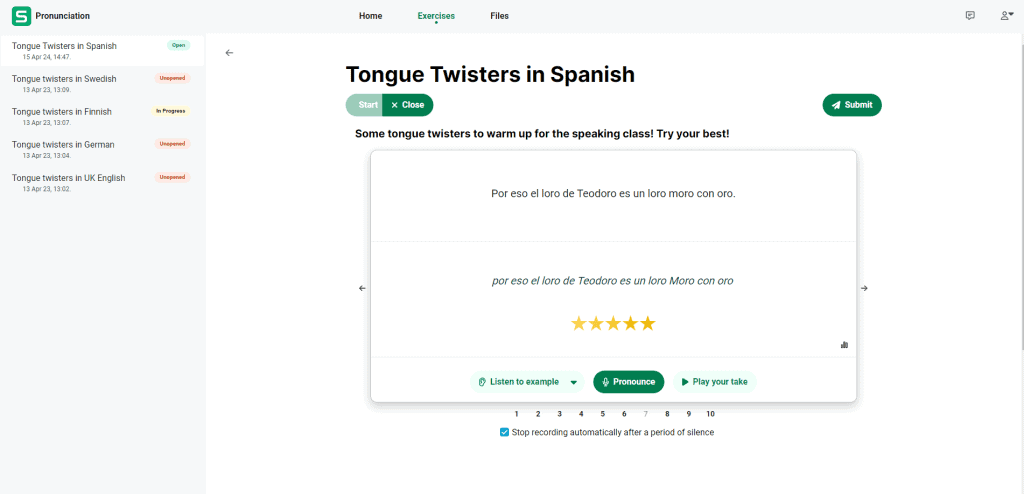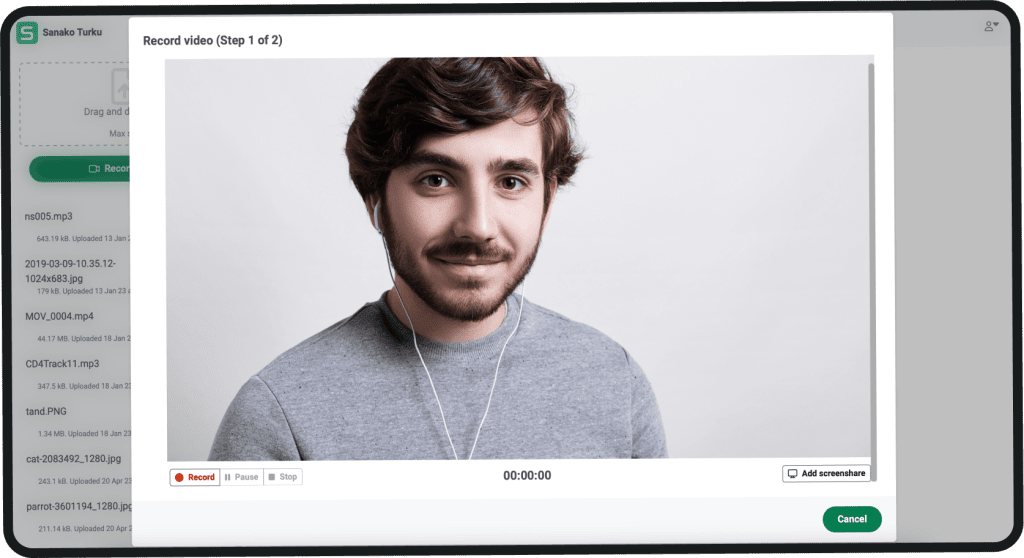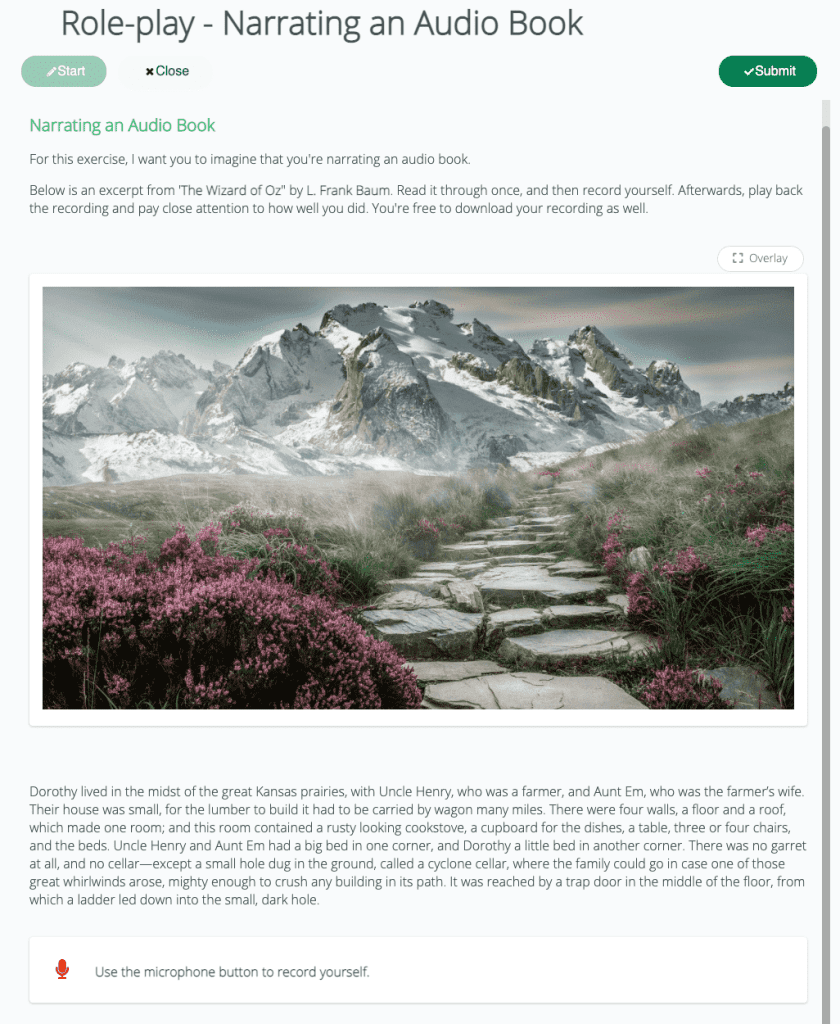As language educators, our primary goal is to equip our students with the skills necessary to communicate effectively in their target language. While traditional teaching methods undoubtedly play a crucial role in achieving this objective, it’s essential to explore innovative strategies that can amplify our students’ learning experiences. One such strategy that often remains underutilized yet holds immense potential is voice recording.
Incorporating voice recording into our teaching practices can revolutionize the way we approach language education. Not only does it provide students with more practice time to refine their speaking skills, but it also offers language educators invaluable insights into their individual students’ progress and areas for improvement. In this blog post, we’ll explore the benefits of integrating voice recording into language learning, both within the classroom and as part of students’ homework assignments.
Why is voice recording so important in language teaching?
By recording your language learners’ speech during class activities and assignments, educators can create a comprehensive feedback loop. These recordings serve as tangible evidence of students’ language proficiency and allow educators to provide targeted feedback tailored to individual needs. Additionally, students can self-review their recordings to identify areas for improvement independently, fostering autonomy in their language learning journey. Hearing themselves speak can often be a truly eye opening experience for students.
Well designed voice recording activities can also offer students a chance to practice authentic communication in real-world contexts, mirroring situations they may encounter in their personal and professional lives. Whether engaging in conversational dialogues, delivering presentations, or participating in group discussions, students can develop practical speaking skills that go beyond the normal academic settings.
One of the most significant challenges language learners face is mastering intonation and pronunciation. Voice recording provides a tool for students to focus on these crucial aspects of spoken language in a controlled environment. By listening to their recordings and receiving feedback from educators, students can refine their pronunciation, intonation, and stress patterns, ultimately enhancing their overall speaking proficiency.
Engaging in regular voice recording activities encourages students to reflect on their language learning progress and identify areas of strength and weakness. Through self-assessment and metacognitive processes, students gain a deeper understanding of their learning strategies and can make informed decisions about their language learning goals. Moreover, the act of recording and listening to oneself fosters self-awareness and confidence in speaking, empowering students to overcome communication apprehension and linguistic barriers.
In the following chapters, we’ll delve deeper into practical strategies for implementing voice recording in language teaching, from incorporating it into classroom activities to designing meaningful homework assignments.
Integrating voice recording into your classroom activities
Now that we’ve explored the rationale behind incorporating voice recording into language education, let’s explore 5 practical strategies for using this powerful tool in your language classroom.
1. Presentations and role-plays
One effective way to leverage voice recording is through oral presentations and role-plays. Assign students topics or scenarios relevant to their language proficiency level and encourage them to record themselves delivering the presentation or engaging in the role-play. This not only provides students with an opportunity to practice speaking in a structured setting but also allows educators to assess their fluency, coherence, and pronunciation.
2. Peer feedback sessions
Create a collaborative learning environment by incorporating peer feedback sessions into classroom activities. After students have recorded their own speaking tasks, pair them up or divide them into small groups to listen to each other’s recordings. Encourage constructive feedback focusing on areas such as pronunciation, intonation, and clarity of expression. This peer-to-peer interaction not only promotes active engagement but also reinforces learning through social interaction and dialogue.
3. Pronunciation drills and model-imitation activities
Provide students with audio recordings of native speakers or model pronunciation yourself, and have your students then record themselves imitating the pronunciation and intonation patterns. Encourage repeated practice and self-assessment, allowing students to compare their recordings with the model and make adjustments accordingly. This iterative process helps students internalize correct pronunciation and develop a more natural speaking rhythm.
Modern language teaching tools like Sanako Connect, allow teachers to leverage AI-powered automatic pronunciation grading to create unlimited opportunities for their students to do pronunciation drills and model-imitation activities. Language teachers who are using Sanako Connect can easily create a series of exercises for their students to work through for a particular lesson or topic. Single words, sentences or paragraphs of L2 text can be typed (or just copied and pasted) into the task creator within Sanako Connect, which then automatically creates pronunciation exercises out of the example text.
When students open the exercises they begin by listening to the first word, sentence or phrase that the teacher has added. Our text-to-speech technology has automatically converted the text into a spoken audio of native speaker authenticity and quality.
After listening the model audio, the student speaks, replicating what they have heard. A recording is made of their speech and the student then receives automatically generated feedback on their pronunciation via a speech recognition engine.
If you want to learn more on how our automated pronunciation grading technology can help you, check out our dedicated blog post “Automatic grading for developing students’ fluency and speaking skills“.
4. Live discussion activities
Create opportunities for interactive live dialogue practice using voice recording. Pair students up or organize group discussions on various topics, and have them record their conversations. Encourage authentic communication by providing prompts or example scenarios that prompt spontaneous responses. Listening to these recordings allows students to identify areas for improvement in real-time communication skills such as turn-taking, negotiation of meaning, and active listening.
5. Speaking diaries
Integrate voice recording into reflective journaling activities to encourage metacognitive awareness and self-reflection. Prompt students to record their thoughts, feelings, and observations about their language learning journey, including challenges, successes, and goals. Listening back to these recordings enables students to track their progress over time, identify patterns in their language development, and set personalized learning objectives. To learn more about this strategy, check out our earlier post on “How a speaking diary helps build students’ fluency“.
By incorporating these 5 strategies into our classroom activities, you can create a dynamic learning environment that promotes active engagement, develops language proficiency, and empowers your students to take ownership of their learning. In the next chapter, we’ll explore how to extend the benefits of voice recording in language teaching beyond the classroom through meaningful homework assignments.
Voice recording as a homework assignment
By assigning voice recording tasks as part of students’ independent study, educators can reinforce key learning objectives, provide additional opportunities for practice speaking skills, and promote learner autonomy. Let’s explore some practical approaches to incorporating voice recording into homework assignments.
1. Speaking prompts
Assign students speaking prompts that are relevant to the topics covered in the previous class. Encourage them to record their responses or performances outside of class time, allowing for flexibility in scheduling and practice. Always remember to provide clear instructions and criteria for evaluation, emphasizing key language structures, vocabulary, and pronunciation targets. This enables students to apply what they’ve learned in class to real-life situations and develop confidence in their speaking abilities.
If you are using language teaching tools like Sanako Connect, you can easily record the speaking prompts with just a few clicks. With Sanako Connect, language teachers can record their video as the speaking prompt and then add a task for the students to record a video or audio response. After recording their response the students can submit their work back to you for review in the same platform.
2. Pronunciation Challenges
Target specific pronunciation challenges by assigning minimal pairs or tongue twisters for students to practice and record. Provide feedback on their recordings, highlighting areas for improvement and suggesting pronunciation exercises or techniques to address difficulties. Encourage repeated practice and self-correction, emphasizing the importance of accurate pronunciation in effective communication.
Again, with Sanako Connect, you can just use the automated pronunciation grading feature and let the system auto-grade your students pronunciation practices saving a lot of time and effort for you.
3. Narrative storytelling
Foster creativity and language expression by assigning narrative storytelling tasks. Prompt your students to record themselves narrating a personal anecdote, retelling their favorite story, narrating an audio book passage, or improvising a short narrative based on a given prompt. Encourage them to incorporate descriptive language, vivid imagery, and varied sentence structures to engage their audience. Listening to their recordings allows students to evaluate their storytelling skills and refine their ability to convey meaning effectively through spoken language.
By incorporating these example homework assignments, educators can capitalize on the benefits of voice recording to enhance students’ speaking skills, promote active engagement, and reinforce learning outside of the classroom.
If you are interested in learning more about how Sanako Connect supports language teachers and students and would like to see how it could benefit your institution, click here or the banner below to learn more and to book a FREE remote demo.




